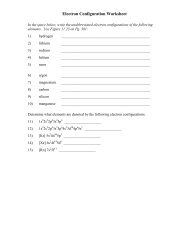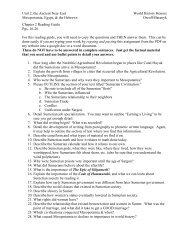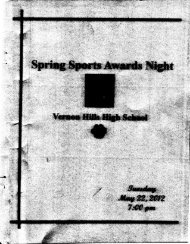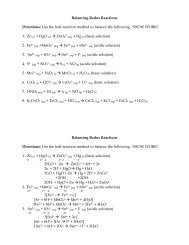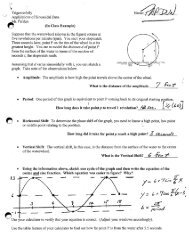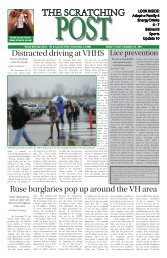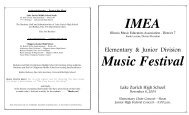OVERVIEW OF ALGAE
OVERVIEW OF ALGAE
OVERVIEW OF ALGAE
You also want an ePaper? Increase the reach of your titles
YUMPU automatically turns print PDFs into web optimized ePapers that Google loves.
HRW material copyrighted under notice appearing earlier in this work.<br />
Name Class Date<br />
SECTION 27-1 REVIEW<br />
<strong>OVERVIEW</strong> <strong>OF</strong> <strong>ALGAE</strong><br />
VOCABULARY REVIEW Distinguish between the terms in each of the following pairs<br />
of terms.<br />
1. gametangium, sporangium<br />
2. unicellular alga, colonial alga<br />
3. zoospore, zygospore<br />
4. antheridium, oogonium<br />
5. gametophyte, sporophyte<br />
MULTIPLE CHOICE Write the correct letter in the blank.<br />
1. Algae differ from other protists in that they are<br />
a. heterotrophic.<br />
b. photosynthetic.<br />
2. The body portion of an alga is called a<br />
a. pyrenoid. b. holdfast. c. sporophyte. d. thallus.<br />
3. Algae are classified into phyla based on all of the following except their<br />
a. type of photosynthetic pigment.<br />
b. form of food storage.<br />
4. Which of the following cells in the life cycle of Chlamydomonas is diploid?<br />
a. zygospore b. zoospore c. “plus” gamete d. “minus” gamete<br />
5. A life cycle that exhibits alternation of generations has<br />
c. always multicellular.<br />
d. always unicellular.<br />
c. presence or absence of flagella.<br />
d. cell wall composition.<br />
a. two distinct unicellular phases.<br />
b. two distinct multicellular phases.<br />
c. a unicellular phase that alternates with a multicellular phase.<br />
d. an algal phase that alternates with a plant phase.<br />
Modern Biology Study Guide<br />
145
Name Class Date<br />
SHORT ANSWER Answer the questions in the space provided.<br />
1. Describe two differences between algae and plants.<br />
2. What type of algae are the major constituents of phytoplankton?<br />
3. Name two ways that phytoplankton is important to other organisms.<br />
4. Why are the reproductive cells of Chlamydomonas called plus gametes and minus gametes<br />
rather than sperm and eggs?<br />
5. In which phase of the life cycle of Ulva does meiosis occur?<br />
6. Critical Thinking What does the diversity that exists among algae suggest about the<br />
evolutionary history of algae?<br />
STRUCTURES AND FUNCTIONS Label each figure in the spaces provided.<br />
The diagram below illustrates sexual reproduction in Oedogonium.<br />
a<br />
b<br />
c<br />
146 Section 27-1 Review<br />
d<br />
e<br />
f<br />
g<br />
HRW material copyrighted under notice appearing earlier in this work.
4. Since protozoa are eukaryotes, their chromosomes<br />
are contained inside a nucleus, which must<br />
break down and then reform for conjugation to<br />
occur. Bacteria lack a nucleus, so division and<br />
exchange of genetic material is simpler in them.<br />
5. Protozoa are unicellular and are separated from<br />
their environment only by their cell membrane.<br />
For protozoa to be metabolically active, the cell<br />
membrane must be in contact with water.<br />
STRUCTURES AND FUNCTIONS<br />
1. locomotion; 2. digestion of food particles;<br />
3. locomotion; 4. detection of light;<br />
5. locomotion and food capture<br />
Section 26-2<br />
VOCABULARY REVIEW<br />
1. Both are parts of a sarcodine’s cytoplasm. The<br />
endoplasm is the inner portion, and the ectoplasm<br />
is the outer layer.<br />
2. Both are openings on the surface of a paramecium.<br />
Food enters the gullet through the<br />
mouth pore, and undigested food molecules<br />
are expelled through the anal pore.<br />
3. Both contain DNA. The macronucleus is large, contains<br />
multiple copies of DNA, and is responsible<br />
for metabolic functions, and the micronucleus is<br />
small and participates in the exchange of genetic<br />
material during conjugation.<br />
MULTIPLE CHOICE<br />
1. b 2. a 3. c 4. d 5. c<br />
SHORT ANSWER<br />
1. The hard tests that cover the bodies of these<br />
organisms sink to the bottom of the ocean, where<br />
they accumulate as layers of sediment.<br />
2. Cilia lining the oral groove sweep food down the<br />
groove to the mouth pore, which opens into the<br />
gullet. Food passes from the gullet into food vacuoles,<br />
where digestion occurs. Undigested molecules<br />
are expelled via the anal pore.<br />
3. trypanosomiasis (sleeping sickness), increasing<br />
fever, lethargy, mental deterioration, and coma;<br />
Chagas’ disease, fever and severe heart damage;<br />
leishmaniasis, disfiguring skin sores; and giardiasis,<br />
severe diarrhea and intestinal cramps<br />
4. The protozoans use the circulatory system of their<br />
human and mosquito hosts to transport them<br />
through their hosts’ bodies, and they depend on<br />
the mosquitoes to transport them from one<br />
human host to another.<br />
STRUCTURES AND FUNCTIONS<br />
a, sporozoite; b, sporozoite; c, liver; d, merozoite; e,<br />
red blood cells; f, gametocyte<br />
Section 27-1<br />
VOCABULARY REVIEW<br />
1. A gametangium is an algal cell that produces<br />
gametes; a sporangium is an algal cell that produces<br />
zoospores.<br />
2. A unicellular alga consists of a single cell; a colonial<br />
alga consists of groups of cells acting in a<br />
coordinated manner.<br />
3. A zoospore is a haploid, flagellated reproductive<br />
cell; a zygospore is a diploid zygote with a thick<br />
protective wall.<br />
22<br />
Modern Biology Study Guide Answer Key<br />
4. An antheridium is a gametangium that produces<br />
sperm; an oogonium is a gametangium that produces<br />
an egg.<br />
5. A gametophyte is a haploid, gamete-producing<br />
phase of an alga; a sporophyte is a diploid, sporeproducing<br />
phase of such an alga.<br />
MULTIPLE CHOICE<br />
1. b 2. d 3. c 4. a 5. b<br />
SHORT ANSWER<br />
1. Algae lack tissue differentiation and have no true<br />
roots, stems, or leaves; plants have these tissues.<br />
Algae form gametes in single-celled gametangia;<br />
plants form gametes in multicellular gametangia.<br />
2. unicellular algae<br />
3. Phytoplankton produces carbohydrates, forming<br />
the foundation of aquatic food chains; phytoplankton<br />
is a major producer of oxygen in the<br />
atmosphere.<br />
4. Chlamydomonas gametes look similar.<br />
5. Meiosis occurs in the sporophyte phase.<br />
6. There were many different origins of algae or<br />
modern algae do not share a recent common<br />
ancestor.<br />
STRUCTURES AND FUNCTIONS<br />
a, antheridium; b, egg; c, oogonium; d, sperm;<br />
e, zygote; f, zoospore; g, holdfast<br />
Section 27-2<br />
VOCABULARY REVIEW<br />
1. Both are pigments; fucoxanthin is found in brown<br />
algae, and phycobilins are found in red algae.<br />
2. Both are parts of brown algae; the stipe is the<br />
stemlike portion, and the blade is a leaflike region.<br />
3. Both are components of the cell walls of some red<br />
algae; carageenan is used in producing cosmetics,<br />
gelatin capsules, and cheese, while agar is used as<br />
a gel for culturing microbes.<br />
4. Diatoms make up a phylum of shelled algae;<br />
when diatoms die, their shells accumulate at the<br />
bottom of oceans and lakes, forming diatomaceous<br />
earth.<br />
MULTIPLE CHOICE<br />
1. a 2. b 3. d 4. c 5. a<br />
SHORT ANSWER<br />
1. Body forms include single cells, colonies, and<br />
multicellular filaments and sheets.<br />
2. water, soil, rock surfaces, tree trunks, inside the<br />
cells of invertebrates, and inside lichens<br />
3. Rhodophyta; they contain phycobilins, which can<br />
absorb wavelengths of light that penetrate deep<br />
into the water.<br />
4. Diatoms have cell walls called shells that consist<br />
of two pieces that fit together.<br />
5. the presence of chlorophyll and the ability to photosynthesize;<br />
the absence of a cell wall and motility<br />
6. Brown, red, and some green algae are multicellular,<br />
like plants. Many of these algae also have<br />
structures that resemble the roots, stems, and<br />
leaves of plants.<br />
STRUCTURES AND FUNCTIONS<br />
a, blade; b, stipe; c, holdfast<br />
HRW material copyrighted under notice appearing earlier in this work.



